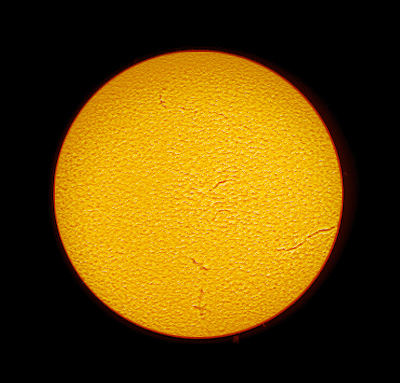|

|
2
April 2006
A
single B&W image processed to bring out as much detail in the disc
as I could get.
If I move back from the monitor, I can see the
swirls between the sunspots much better, try it.
|
|

|
2 April 2006
A colourised single image to show the proms (overexposed by 2 stops.)
|

|
2 April 2006
A combination of the two to try to show roughly what the
view was like at the eyepiece. It doesn't compare to what you can see
once your eyes are tuned in to picking out the detail.
|

|
4 April 2006
Two days later, and we have an amazing "waterfall" prominence as well
as swirls and a faint filament amongs the sunspots.
|

|
4 April 2006
Close up of the sunspots.
|

|
4 April 2006
Closeup of the prominence.
This one shows the most structured I have seen so far.
|

|
4 April 2006
This is a raw image from the camera. I took about 50 and stacked as
many as I could to get a working image of the disc with its structures
to work with.
|

|
4 April 2006
I overexpose by 2 stops to get images of the prominence. Remember, they
are a million times dimmer than the photosphere, that's the bit most of
the light of the Sun comes from.
This is just one of the raw images from the camera.
Five of the best from the 50 I took were aligned, rotated and adjusted
with Photoshop to bring out as much detail as I could get.
|

|
14 April 2006
Not many prominences today but several long and complex filaments
snaking across the Sun's disc.
I changed my technique for this image. I used a 40mm Nexstar Plossl
eyepice to try to get a sharper focus and I used a Gaussian Blur to
produce a Flat Field in order to improve the detail near the limb. The
downside was that this is the actual size of the imageso I cannot show
any details on the disc. I think it was worth it to bring out the
various filaments which were visible.
|

|
23 April 2006
A string of cloud-like filaments has moved across the Sun in the last
few days. As the reached the limb yesterday they put on a fantastic
display but unfortunately, it was cloudy all day in Forres.
Today, however, was very different, and I managed to image some
prominences which were bigger and more complex than those I saw on the
4th of the month.
disc detail was very limited so I decided to concentrate on the
prominences. This image is a composite of three, stacked using Registax
and slightly tweaked using Photoshop.
|

|
23 April 2006
This is a view of the prominences, colourised using Photoshop.
|

|
23 April 2006
Detail of the biggest prominence.
|

|
26 April 2006
The spectacular prominence display is now over but Active Area 875 is
now moving across the Sun's disc.
This is the first time I have been able to image a prominence while
part of the gas cloud is still visible as a diffuse filament on the
solar disc. It gives it a 3-D effect.
|

|
26 April 2006
Close up of the active area.
|

|
26 April 2006
Prominences shown as a ring.
|

|
26 April 2006
A white light image taken using a Thousand Oaks filter on my ETX 90.
Colourised in Photoshop to make it look similar to the H-alpha images.
This image and the one below have the same orientation as the h-alpha
images above, i.e. north at the bottom.
|

|
26 April 2006
Close up of Active Area 875.
|

|
30 April 2006
Active Area 875 has produced a
few flares in the last few days and was still very bright this morning.
The bright region at 4 o'clock shows another "plage" area with some
nice prominences nearby.
The long dark streak in the upper right of the image promises some more
good prominences when it rolls off the Sun's limb.
|